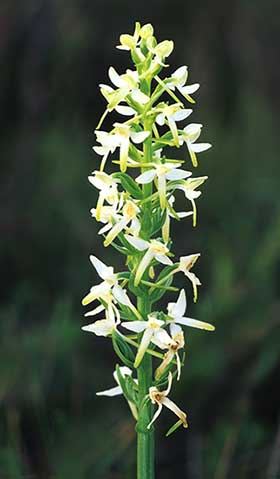Lesser butterfly-orchid (Platanthera bifolia)
When: June - July
How many: Relatively widespread and may be abundant

Both lesser butterfly-orchids and greater butterfly-orchids are found in Hampshire, but only lesser butterfly-orchids, the scarcer of the two in southern England, occur in the New Forest.
Lesser butterfly-orchids are subtly beautiful plants, the most delicate of the New Forest orchids. Late-spring and early-summer flowers bloom in a long, loose, cylindrical spike, and are of a pale, greenish-white or sometimes almost yellow colour.
An exotically long and slender, downward curving, nectar-containing spur flows out behind each lesser butterfly-orchid flower, whilst the flower’s lengthy central lip is flanked on either side by a single, pointed spreading petal. The whole is topped by a delicate loose hood of petals and sepals.
To separate lesser butterfly-orchids from their close relative, look within each flower for clearly visible parallel pollen masses, rather than the converging pollen masses of the greater butterfly-orchid.
Lesser butterfly-orchid flowers show up well in the dark, for night-flying moths are important pollination agents, attracted by a rich fragrance that is considerably stronger at night than in the daytime. Greater butterfly-orchids, which also share this habit, were quite fittingly known as night violets.
Some authorities believe that two different forms of lesser butterfly-orchid occur in the New Forest. One inhabits the valley mires and surrounding wet areas, and is said to be a shorter, stockier plant with shorter, broader leaves and flower-spike. The second, found amongst woodland/heathland-edge bracken, is taller and more spindly, with longer, narrower, lance-shaped leaves, and whiter flowers.
John Gerard, writing in 1597, noted lesser butterfly-orchids as: ‘That kinde which resembleth the white Butter-flie’, although in contrast, Curtis in his Flora Londinensis, perhaps more accuratelyremarked ‘the English name of Butterfly Orchis is scarcely warranted by the appearance of the flowers.’
Gerard considered that lesser butterfly-orchids were of no great use in herbal, country medicine, but were ‘regarded for the pleasant and beautiful flowers, where with nature hath seemed to plaie and disport hir selfe’.
References:
Wild Orchids of Hampshire and the Isle of Wight: Martin N. Jenkinson
The Flora of Hampshire: Anne Brewis, Paul Bowman and Francis Rose
The Encyclopedia of British Wild Flowers: John Akeroyd
The Englishman’s Flora: Geoffrey Grigson
The Herball or General Historie of Plantes: John Gerard
Reader’s Digest Field Guide to the Wild Flowers of Britain
More links
Other related links
Search this site

Sadly, 58 animals were killed - 35 ponies, 13 cows, 8 donkeys and 2 sheep, whilst a further 32 were injured - 3 pigs, 9 donkeys, 11 cows and 9 ponies.
(Forty-three accidents occurred in daylight, 15 at twilight and 101 in the dark. Twenty-seven accidents were not reported by the driver involved).
Here's just one horrific example - Three donkeys killed in collision with van at notorious New Forest blackspot (Advertiser and Times)

